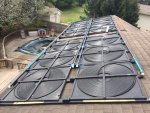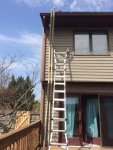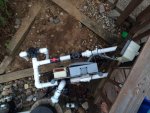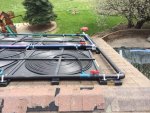- Aug 19, 2008
- 7
Hello All!
I’ve recently finished installation of solar panels for my pool, in which I’m trying to troubleshoot my flowrate/performance. This was a DIY project that I started last fall, knowing that it will undoubtedly be less efficient than a commercial system (no going back now!).
My collector panels are made up of ½” black poly-tubing coiled on a 4’ x 4’ piece of black painted plywood. I have 12 panels, each with approximately 200 ft of poly-tubing. They are mounted on a 2 story roof (approx. 25’ high). I am running the panels in parallel, two rows of 6 panels. Panels are facing directly east in southern Michigan --unfortunately we don’t have a south facing roof, and I could not convince my wife to let me install them facing the west (towards the road).
Volume of our pool is approx. 23K gallons, with supply/return lines of 1.5” diameter. The mounting location is approximately 60’ from my equipment pad (35’ horizontal, 25’ vertical). I utilized 2” PVC from the 3-way diverter valve up to the panel headers, which reduces to a 1.5” header connecting to the ½” tubing at the panels. I am using the Pentair SolarTouch controller. I’ve attached several pics of my setup for reference.
I took suction-side and discharge-side pressure readings on my pump last year before installing the panels, which allowed me to estimate 50 feet of TDH, and 62GPM from the pump curve. My pump is a Sta-Rite Duraglas 1hp (Model: P2Ra5E-181L). My filter is a Hayward EC-65 (DE). Filter pressure is typically 8 psi when solar is off.
During normal operation, I’ve been diverting 75% of the water to the panels with the other 25% direct return to the pool. I generally see a 10 psi increase in filter pressure with solar on (reading is ~18 psi), which makes sense given the 25’ elevation.
My problem is that I’m having trouble getting adequate flow. Here’s a summary of what I’ve observed:
•Normal Operation - All 12 solar panels open; divert 75% water to solar panels. RESULT: Average combined flow rate from the 12 panels is 21 gpm (i.e. <2gpm per panel). Measured pressure at the supply header on the roof is 3 psi –does a 15 psi pressure drop from filter to roof seem excessive?
•All 12 solar panels open, divert 100% to the panels. RESULT: Average combined flow rate of 23.5 gpm from the panels.
•6 panels closed, 75% diverted to solar. RESULT: Average of 3gpm from each of the 6 open panels.
•11 panels closed, 75% diverted to solar. RESULT: 4 gpm from the 1 open panel.
•All 12 solar panels open; divert <75% water to solar panels. RESULT: Water unable to make it through the panels back to the pool.
At this point, in order to increase flow I assume I need either: A) Larger pump, or B) Booster pump. Any recommendation as to which route is better, or if there is any other trouble-shooting advice? I've seen many other posts indicating that similar sized pumps (0.75hp, 1hp) have been adequate for their solar installations on 2-story houses --not sure if the coil design is the contributing factor for my issue?
Other notes that may or may not be relevant:
•At both of the coil discharge headers, I can feel vacuum being pulled when I disconnect a coil. Gravity must be helping pull water through panels.
•When diverting at least 75% to the panels, I can tell just by feeling return jets at the pool that I’m getting less flow/circulation.
PS.
Here are the results on a very small-sample size of panel performance thus far:
We had an 80% sunny day yesterday, outdoor temp in the morning was low-70s with temps peaking at 83F in the afternoon. Pool temp was 68F at 6AM, and 73F at 4PM. Given the warm temps and large quantity of sun, I was hoping for a higher increase by the end of the day. Note: For reference, neighbor who has similar size pool without solar cover had water temp of 72F by the end of yesterday.
I’ve recently finished installation of solar panels for my pool, in which I’m trying to troubleshoot my flowrate/performance. This was a DIY project that I started last fall, knowing that it will undoubtedly be less efficient than a commercial system (no going back now!).
My collector panels are made up of ½” black poly-tubing coiled on a 4’ x 4’ piece of black painted plywood. I have 12 panels, each with approximately 200 ft of poly-tubing. They are mounted on a 2 story roof (approx. 25’ high). I am running the panels in parallel, two rows of 6 panels. Panels are facing directly east in southern Michigan --unfortunately we don’t have a south facing roof, and I could not convince my wife to let me install them facing the west (towards the road).
Volume of our pool is approx. 23K gallons, with supply/return lines of 1.5” diameter. The mounting location is approximately 60’ from my equipment pad (35’ horizontal, 25’ vertical). I utilized 2” PVC from the 3-way diverter valve up to the panel headers, which reduces to a 1.5” header connecting to the ½” tubing at the panels. I am using the Pentair SolarTouch controller. I’ve attached several pics of my setup for reference.
I took suction-side and discharge-side pressure readings on my pump last year before installing the panels, which allowed me to estimate 50 feet of TDH, and 62GPM from the pump curve. My pump is a Sta-Rite Duraglas 1hp (Model: P2Ra5E-181L). My filter is a Hayward EC-65 (DE). Filter pressure is typically 8 psi when solar is off.
During normal operation, I’ve been diverting 75% of the water to the panels with the other 25% direct return to the pool. I generally see a 10 psi increase in filter pressure with solar on (reading is ~18 psi), which makes sense given the 25’ elevation.
My problem is that I’m having trouble getting adequate flow. Here’s a summary of what I’ve observed:
•Normal Operation - All 12 solar panels open; divert 75% water to solar panels. RESULT: Average combined flow rate from the 12 panels is 21 gpm (i.e. <2gpm per panel). Measured pressure at the supply header on the roof is 3 psi –does a 15 psi pressure drop from filter to roof seem excessive?
•All 12 solar panels open, divert 100% to the panels. RESULT: Average combined flow rate of 23.5 gpm from the panels.
•6 panels closed, 75% diverted to solar. RESULT: Average of 3gpm from each of the 6 open panels.
•11 panels closed, 75% diverted to solar. RESULT: 4 gpm from the 1 open panel.
•All 12 solar panels open; divert <75% water to solar panels. RESULT: Water unable to make it through the panels back to the pool.
At this point, in order to increase flow I assume I need either: A) Larger pump, or B) Booster pump. Any recommendation as to which route is better, or if there is any other trouble-shooting advice? I've seen many other posts indicating that similar sized pumps (0.75hp, 1hp) have been adequate for their solar installations on 2-story houses --not sure if the coil design is the contributing factor for my issue?
Other notes that may or may not be relevant:
•At both of the coil discharge headers, I can feel vacuum being pulled when I disconnect a coil. Gravity must be helping pull water through panels.
•When diverting at least 75% to the panels, I can tell just by feeling return jets at the pool that I’m getting less flow/circulation.
PS.
Here are the results on a very small-sample size of panel performance thus far:
We had an 80% sunny day yesterday, outdoor temp in the morning was low-70s with temps peaking at 83F in the afternoon. Pool temp was 68F at 6AM, and 73F at 4PM. Given the warm temps and large quantity of sun, I was hoping for a higher increase by the end of the day. Note: For reference, neighbor who has similar size pool without solar cover had water temp of 72F by the end of yesterday.







